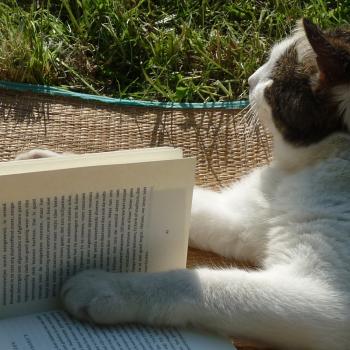Previous years can be found here. As always, “best” and “favorite” are shifting categories; I felt that most keenly this year with The Farewell. Post title via Leslie Jamison’s The Recovering.
Best books read for the first time (non-fiction): This year I read a lot about slavery and related issues of domination and subjugation, which is all leading up to a long-term fiction project. (“You can say ‘novel,’ you know. We’re all moderns here.”) You’ll see the marks of this particular obsession in more than one of these best-of lists, and you should feel very free to suggest books I should read, movies, articles, pop-opera song cycles etc etc, given what I say here.
So, the best non-fiction books I read unrelated to this project were: Claudia Rapp, Brother-Making in Late Antiquity and Byzantium: Monks, Laymen, and Christian Ritual. This is a very good, careful work which makes clear the many differences between this form of kinship and the vowed friendships or “wedded brotherhoods” depicted by Alan Bray. Rapp attends to the spiritual power of these relationships as much as to the social conflicts they sometimes managed and sometimes exacerbated. I’m always here for “you can’t solve your problems, but you can get more-Christian problems,” and that’s the world she depicts here.
Miri Rubin, Corpus Christi: The Eucharist in Late Medieval Culture. “I expected this book to be good Lenten reading. I did not expect–though I should have–that it would be so relevant to this specific Lent.”
St. Augustine, Confessions. Translated by Thomas Williams. This is only at #3 because I’ve read two translations of it before, but in fact this is the one I’d start with if you’re new to the guy: “Williams translates with great love for the barbarians.” (Should I put memoir in the “non-fiction” section, really?)
Caroline Walker Bynum, Jesus as Mother: Studies in the Spirituality of the High Middle Ages. Cistercians, man. So beautiful.
John D. Fitzgerald, Papa Married a Mormon. (Should I put memoir in the “non-fiction” section, really?) This book by the author of the Great Brain children’s series was published by an outfit called Western Epics, and boy howdy, does it fit the bill. Shootouts at a silver-mine boom town, rabid dogs and vicious men, gamblers and fancy women, drunken doctors and stouthearted newspaper men–it’s all here. But the book also shows a side of America often excised from portrayals of the Old West: constant, intense and sincere religious conversion. Seems like everybody in this book goes through at least two religions! Mostly they swing around the Catholic-Mormon axis of Fitzgerald’s parents’ marriage (his dad sweeps his mom away in the night and they have to hide in a barrel while angry gun-toting Mormons hunt them!) although you also get a lot of sinner -> penitent action, always a pleasure. Fitzgerald himself ended up Catholic iirc, which may explain why the book bends over backwards to protect the reputation of the LDS Church. (I seem to recall that the local Mormons were practicing polygamy during parts of this narrative, but we never see it on the page.) Caveat lector, at the beginning he repeats an ancestor’s judgments of the dirtiness and low morals of the local Indians, but that’s western epics for you.
Best non-fiction books which are obviously linked by a theme: Kyle Harper, Slavery in the Late Roman World: AD 275 – 425. I took a lot of notes here but one thing that stood out was that slavery relied on wealth, secure transportation systems, and good communication across long distances, and the slave society of the Romans receded not with the rise of Christianity but with the failure of these structures of power. It’s easy for rich societies to be bad. ETA: Probably most helpful to say I read this book because of quotations like, “Christians may have been anxious about the practice of tatooing runaway slaves on the face (because it was the image of God, perhaps); that possibility could account for the sudden appearance in late antiquity of the practice of using iron collars” and, “For Gregory, poverty was an insult to the beauty of man’s rational nature ….” both of which I think I first found here.
Kyle Harper, From Shame to Sin: The Christian Transformation of Sexual Morality in Late Antiquity. In certain respects weaker than his more-academic book (it’s more tendentious, for example) but I loved the use of late antique novels to show the shifting views of slavery, free will, and eros. Wild to see how Christians picked up and transformed–though not always enough!–the tropes of pagan fiction.
Stephanos Bibas, The Machinery of Criminal Justice: “Many of the practices Bibas promotes—restorative justice conferences, sentencing juries, encouraging both victims and defendants to speak in court—can rebuke and change the community as well as individual wrongdoers. Nothing excuses cruelty to others, the dehumanization many robbers and violent criminals project onto their victims. Nothing, also, excuses the community that fails a person starting in childhood and only notices him when he commits a crime. How can the rich man enter Heaven? How can the judge find mercy? Only in embracing the good of punishment—for himself.”
Orlando Patterson, Slavery and Social Death: A Comparative Study. Magisterial and intense. One central contention is that slavery is defined not by e.g. being sold (as Harper argues) but by social death and natal alienation–being treated as one civilly dead, and being deprived of any enforceable duty or right to one’s parents and children. Patterson follows this form of culture through five continents and in societies ranging from small tribes to the slave empires of the Roman and Atlantic trades.
James Scott, Domination and the Arts of Resistance: Hidden Transcripts. I sort of reviewed this in my Parasite review.
Andrea Long Chu, Females. Review forthcoming! Front half is much stronger than the back, and I don’t recommend this for everyone, but I laughed a lot and was delighted by some of Chu’s challenges.
And Jon Ronson’s So You’ve Been Publicly Shamed is uneven and doesn’t ask the questions I would want asked (especially in the chapter on “creative sentencing” to public humiliation), but if you’re interested in its subject it is very worth reading and includes many voices usually left out of these discussions, very much including the subjects of shaming themselves.
Also notable, in order of when I read them: Sharon Leon, An Image of God: The Catholic Struggle with Eugenics; Brenna Moore, Sacred Dread: Raissa Maritain, The Allure of Suffering, And the French Catholic Revival (1905 – 1944); Graham Greene, The Lawless Roads; Carrie Frost, Maternal Body: A Theology of Incarnation from the Christian East.
Best fiction books I read for the first time: Antonia White, Frost in May. And I’d put Beyond the Glass on this list too. “Frost in May, Antonia White’s novel drawing on her own convent education in the years leading up to World War I, layers satire, anguish, and tenderness with exceptional delicacy. The school novel is always a novel of the gap between what’s taught and what’s learned. The faith of the Convent of the Five Wounds is sentimental, it’s cruel, it turns truths into propaganda and breaks children’s spirits in the name of humility. And yet it’s also beautiful.”
Charles Johnson, Middle Passage: “Johnson is a Buddhist the way Graham Greene is a Catholic: The world he depicts is a world where Buddhism is true, and often his characters do profess all or some of this philosophy, but they also live crosswise to Buddhism, seeking out forms of ecstasy which hint at a misfiring longing for what Buddhism offers.”
The Best of Cordwainer Smith. “To oversimplify a baroque tale: ‘Dead Lady’ is a story about religious love, which is necessarily but not essentially political. D’joan’s tools (the D’ is for dog!) are a saint’s tools, and not actually the weapons of the historical Joan, or at least not her earthly weapons. Her story is powerful on its own but gains from appearing in the same collection as ‘The Ballad of Lost C’mell,’ about a cat-geisha or cat-escort who leads a political movement for underpeople’s rights; also about, as the title hints, the tragic unromance between the cat-woman and a human lord. The details of C’mell’s job, and her assumptions about the human lord, are so vividly and perfectly imagined, from the subtly revealing clothes she has to wear to the way she’s heard many, many men say they want to help the underpeople, right before they make ‘a very raw kind of pass indeed.’ It would be easy for this genre to objectify C’mell; instead Smith imagines her, as a woman who’s had to live within her job and has learned some hard lessons from it.”
Dorothy West, The Living Is Easy: “The things that Cleo never had to be taught were how to hold her head high, how to scorn sin with men, and how to keep her left hand from knowing what her right hand was doing.”
Jay McInerney, Story of My Life: “[A]t a certain point I realized that [Alison Poole]’s one of those luckless, careening disasters who has a code, a personal code of honor, and it’s an absurd code but so poignant in its blatant inadequacy. Alison’s code is honesty, which is hilarious since she surrounds herself constantly with liars and users. She expresses her sincere love for these creeps with all the self-awareness of a literal cocker spaniel. Alison loves everybody, even men!–after all, they’re ‘the only other sex we’ve got.’ So I adored her and saw in her hints of that humility which is impossible to distinguish from damaged self-loathing.”
The most recent Love & Rockets collection, Is That How You See Me?, was an extraordinarily satisfying (possible) conclusion to the greatest comic-book love story of our time, Maggie Chascarillo & Esperanza Glass.
Also in the books section I’ll say that this year, after nine years studying Russian, I read something totally on my own for the first time. It was Pushkin’s Руслан и Людмила. I can’t tell you whether I “liked” it because I’m not good enough at the language yet to have that kind of emotional reaction most of the time, but it was a pleasure to read, in the way that people tell me exercise is sometimes pleasurable.
And last–best book published by me was Punishment: A Love Story:
When Des Schulman returns to Washington, DC under ‘conditional release,’ she wants three things: to repair her relationships, to practice humility, and to stay out of prison. So she reconnects with her local sadomasochists’ group, and pursues an elusive ex. She takes a state-mandated job cleaning (and judging) other people’s houses, flings a few prayers at whatever Higher Power might be listening, and spends her group therapy trying to justify her happy childhood to the women of her halfway house.
But Des’s downwardly-mobile skid through the gentrifying city is more dangerous than she realizes….
Available wherever unwise books are sold! (such as Kindle!)
Best movies watched for the first time: This was not a year of standout movies for me. Us was the best thing I saw, and Us is fantastic–I’d love to see it again and explore its meanings and images–but I think it would fall at about number nine or ten on last year’s list, just above The Favourite. (Which I really should have switched with Sorry to Bother You anyway.) So no shade to any of these movies, not everything can be Salo (thank God), I just don’t want to oversell them to you.
Four Lions
The Last Black Man in San Francisco
Also notable, in order of when I saw them: Can You Ever Forgive Me?, Shoplifting, The Jewish Cardinal, Il Generale della Rovere, Steel Magnolias, Crooklyn, School Daze, The Devil’s Doorway, Bachelor Mother, Citizens Band, To Sleep with Anger, LA Story, Seklusyon, Rafiki, White Nights, Friday, Thief, The Trouble with Angels, The Farewell, Desperately Seeking Susan, Pumpkinhead, Of Unknown Origin (KILLER RATS!!!!), The Interrupters, Parasite, Beauty and the Beast (1978), The Legend of Cool “Disco” Dan, Corpus Christi, The Last Exorcism (review forthcoming).
Best articles by other people: As always, I read at random, so this is far from a comprehensive survey.
BD McClay, “The Ills that Flesh Is Heir To.” Or, a theology of having mono.
Jennifer Percy, “The Priest of Abu Ghraib“: “Two weeks before he got his assignment letter from the Army, he was accepted to seminary school. He chose Iraq.”
Ron Belgau, “Agapao and Phileo by the Sea of Tiberias“: “I will argue that when Peter says, ‘I love [philéo] You,’ he is declaring a more intimate form of love than if he responded ‘I love [agapáo] You.’ I will also argue that by switching from agapáo to philéo, Jesus is helping to confirm Peter’s restoration to friendship with Christ.”
Lizzie Presser, “When Medical Debt Collectors Decide Who Gets Arrested.” This is a reporter with a novelist’s eye for detail and incident. Also this article is what made me decide that I’ll donate to ProPublica in the new year. And I’ll add an Atlantic piece from Will Evans, “Ruthless Quotas Are Maiming Workers at Amazon,” because his perseverance in reporting makes this a work of FOIA noir.
Matthew Walther, “The Immorality of Layoffs.” Does what it says on the tin.
A lot of Melinda Selmys’s writing on the breakup of her marriage, her experience of spousal rape, and the impact of these experiences on her faith has been powerful and necessary; I’d highlight “Why I Am Still Writing for Patheos Catholic.” I expect Melinda’s beliefs and position have shifted since then but this post is an articulation, with both honesty and humility, of something many, many people have experienced.
And in a very different genre, Amy Richlin’s 2014 article, “Talking to Slaves in the Plautine Audience.” What do we know about the people who watched these comedy slave characters, and what aspects of slave experience are depicted, caricatured, or dreamed of here?
Best articles by me: “The value of public penance in the age of clerical abuse, mass incarceration, and #metoo.” Public penance is back baby. It’s good again. Awoouu (wolf Howl).
Against Storytelling, or, my tribute to Salo: And a postscript which is if anything more theological and heartfelt.
Dentistry as a corporal work of mercy: “Our teeth are our biographers.”
I review a biography of Edward Gorey. Camp is the thing with feathers/that perches in the soul.
“How the ‘Celibacy Recession’ Is Affecting Young Catholics.” I’m mainly listing this here because it’s a decent example of how viewing current events solely through the lens of one’s own obsessions can sometimes reveal what others don’t see. “An economic and cultural landscape in which large numbers of young people can’t enter either marriage or religious life – the two most obvious and intelligible forms of self-gift for Catholics – is a landscape in which adulthood is defined not by sacrificial love but by anchorless, humiliated drifting. It is this anchorlessness more than anything which defines the ‘celibacy recession’.”
Best blog posts by me: “Silence as Humility vs. Silence = Death,” though honestly the best stuff in that is taken pretty directly from Renee Higgins at Revoice.
“Notes from a ‘Pilgrimage to Hostage Relics.'” Service journalism for those looking to do some guerrilla reverence in their own towns; and that slavery novel is also a novel about relics, about bones and their adornment and what it means to keep a body around after death. So here are some notes about that. Also, obviously, the “St. Moses” incident has especial resonance in a time of rising attacks on New York’s Jews.
“We Don’t Need No Water“: This is sort of about whether Paul inadvertently supports gay marriage, but mostly about gay people’s relationship to Scripture.
“Were You There When the Stone Was Rolled Away?“: Holy Week in the capital of gentrification.
“A Child’s Garden of Anarchy“: “Since I’ve been re-reading the books I loved at various ages I’ve been struck by the division between two kinds of children’s or YA lit about rebellious, underworld communities: one kind about anarchy, and one kind about anarchism.”
Piece by me that I’m least satisfied with: Honestly, probably my short review of Four Lions, which deserved better from me.
Music I discovered in 2019: This traditional song about Dives and Lazarus; Kesha, “Praying,” aka one of the greatest Christian songs of our time. Video is also both wiggy and heartbreaking.
Best new holiday: Weird Catholic Book Day. YOU’RE WELCOME.
Best gay Christian conference: Yo’ winnah, and still champeen–Revoice! A successful title defense in this category. See you in St Louis 2k20.
Best presentation I gave: No coincidence, it’s the Ecstasy in Celibacy thing from Revoice, even though I was scatterbrained as always and went way under time. Here’s a coda.
Most unexpected conservative emergence: 2019, the year go-go became a conservative movement. Go-go, the sound of the city, the music with which hometown DC has ever distinguished herself from dateline Washington, became a rallying cry and a self-conscious aesthetic resistance to community-disrupting woke capitalism. I’m here for Burkean go-go even though I’m sorry to see it emerge, since conservatism, the defense of home, emerges only once home has been replaced. Anyway, God bless go-go, sic transit Lisa of the World.
And here, have my least-appreciated twittering. Well I thought it was good.
Photo of New Year’s aftermath and cleanup via Wikimedia Commons.












